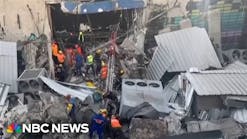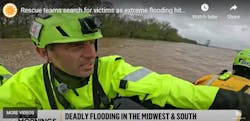The propane explosion that occurred in Waverly, TN, on Feb. 24, 1978, was the high-water mark of hazardous materials incidents in the United States. In terms of loss of life to emergency responders and civilians resulting from train derailments, this incident was the last in which so many people were to die. The Waverly incident also resulted in many changes in tactics for dealing with similar fires in containers and in safety equipment on railroads.
A similar derailment occurred in Weyuwega, WI, in 1996, and the incident commander there used his knowledge of the Waverly incident to formulate tactics. That might have had a direct impact on the Weyuwega incident in terms of safety to emergency personnel and residents. There was not a single serious injury or death as a direct result of the derailment in Weyuwega. We can all learn from lessons from past incidents such as Waverly and be able to protect personnel and the public from harm. Unfortunately, sometimes our memories are very short.
Late-Night Emergency
Waverly is 56 miles west of Nashville and 142 miles east-northeast of Memphis. It is the Humphries County seat and had a population of 5,000 in 1978. Feb. 22, 1978, was a Monday, a typical winter day in northwestern Tennessee. Temperatures hovered in the mid-20s with about a half-inch of snow on the ground.
At approximately 10:30 P.M., a Louisville and Northern (L&N) Railroad train heading from Nashville to Memphis derailed in the small community. Investigators determined that a wheel on a gondola car, overheated from a handbrake left in the applied position, broke apart east of Waverly. A wheel truck damaged by the breaking wheel remained with the train for seven miles before it coming loose from the car and causing the derailment. Twenty-four of the train's 92 cars left the tracks in the center of downtown Waverly.
Two derailed tank cars that contained liquefied propane played a major role in the incident that unfolded over several days. Propane should not be confused with another product called liquefied petroleum gas (LPG), which is a mixture of butane, isobutene, propane, propylene and butylenes.
Properties Of Propane
Propane is a colorless gas with an odor of natural gas (methane). Natural gas and propane do not have an odor naturally, so an odorant is added for leak-detection purposes. Propane vapor is heavier than air. It has a boiling point of -43.67 degrees Fahrenheit and a flash point of -156F. It is extremely flammable with an ignition temperature of 874F and a flammable range of 2.4% to 9.5% in air. Propane is an alkane hydrocarbon compound with a molecular formula of C3H8, which means it is saturated (all single bonds), so polymerization is unlikely. It is non-toxic by inhalation, but can cause asphyxiation by displacing the air in confined spaces.
Photo courtesy of Waverly Fire Department Aerial photo shows the master hose streams placed in service to cool the tanks.
The primary hazard to be concerned about with propane and liquefied petroleum gases is flammability. When liquefied petroleum gases are in a container, a boiling-liquid/expanding-vapor explosion (BLEVE) can occur under certain conditions. Those include direct flame impingement on the vapor space of the container, over pressurization of the container, or physical damage to the container shell or a combination of factors. Incident commanders should be well aware of these potential effects on the integrity of liquefied petroleum gas pressure containers.
The explosion in Waverly was unusual because it did not involve flame impingement on the tank. When the derailment occurred, there were no leaks, no fires, no explosions; nothing overly exciting resulted beyond the derailment of the cars themselves. This may have been one of the primary factors that led response personnel and others to let down their guard, leading to disaster two days later.
First On The Scene
Waverly Fire Department volunteers along with the Waverly Police Department were first on the scene of the derailment. Responders did not have monitoring devices to check for leaks and relied on their sense of smell to determine there was no immediate danger. (Propane has an odor threshold of 1,800 mg/cuM. Using the human senses is not recommended as a means of detection for hazardous materials because of the potential danger to response personnel. Without monitoring equipment, there is no way to know what amount of vapor is present. Responders could become asphyxiated by propane or other gases without proper respiratory protection. They could find themselves in the middle of the flammable range without a meter to determine the amount of vapor/air mixture that is present. This could lead to serious injury or death if ignition occurs.)
Photo courtesy of Waverly Fire Department The explosion and fires killed five people instantly. The Waverly fire chief was burned severely and later died at a hospital. The fire chief’s station wagon car is visible at the center of the photo, next to the large truck.
Following the initial scene survey, a nearby single-family residence and custodial care facility were evacuated as a precaution. Tennessee Civil Defense was notified the next morning, Feb. 23, of the derailment. Initial reports to the agency indicated no hazardous materials were involved. It was not until 5:10 A.M. the following day that Civil Defense authorities were told that hazardous materials were in some of the derailed train cars. With that information in hand, a state hazardous materials team was dispatched to the scene and arrived at 6:30 A.M. Once the hazmat team was on scene, an additional evacuation distance of a quarter-mile was implemented and all electrical and natural gas sources were shut off in the hazard area.
By then, firefighters had already put heavy hose streams in place to cool the derailed tank cars. (A footnote here: Remember that the boiling point of propane is -43.67F. Applying water to tanks that are not on fire can cause the liquid propane to boil faster, increasing the pressure inside the tanks. If the water in the hoselines was just at 32F, the freezing point of water, for example, that is 75 degrees above the boiling point of the liquid propane. In many cases the temperature of the water will be much higher. Water from booster tanks that was in heated fire stations can be in the 70s or higher.)
Tracks Cleared
Railroad personnel began clearing the right-of-way to get rail traffic moving again as soon as possible. They complained the mud created by the "cooling" efforts of emergency responders was making it difficult for their workers, so the hoselines were shut down, but left in place.
Photo courtesy of Waverly Fire Department A piece of railroad tank car 83013. Pieces of the tank car were rocketed 330 feet by the explosion.
By 2:15 P.M., the tracks had been cleared of all derailed cars. One derailed tank car, number 83013, had been moved some 12 feet from its original resting point under several other rail cars. The L&N line was reopened to limited rail traffic at 8 P.M. Up to that point, no efforts had been made to deal with the liquid propane still in the tank cars.
At the direction of the L&N Railroad, crews were dispatched to offload the propane tank cars. They arrived on scene at about 1 P.M. the next day, Feb. 24.
Before the off loading process was to begin, air monitoring of the area with combustible gas indicators revealed no leaks or propane in the area. Because of the lack of catastrophic events surrounding the derailment, the evacuation was relaxed and Waverly was pretty much back to business as usual by the time the off loading was to begin. In fact, people were observed smoking in the area of the derailed propane tank cars. The fire chief, police chief, a fire crew and two representatives of Tennessee Civil Defense were on scene along with railroad workers and personnel from a private contractor.
Before the offloading process could begin, at approximately 2:58 P.M., someone noticed that propane vapors were leaking from tank car 83013. Within seconds, before anyone could react to the leaking propane, a BLEVE occurred. The explosion and resulting fires killed five people instantly and severely burned the Waverly fire chief, who later died at a hospital.
That day, the sky had cleared and the sun had come out, raising the temperature into the mid-50s. One possible contributing factor to the incident indicated by the National Transportation Safety Board (NTSB) was an increase in pressure in the tank. A rising ambient temperature can cause the pressure in a tank to increase. Also, unknown at the time was that a portion of tank car 83013 had been damaged and weakened by the derailment. Emergency responders should keep in mind that railroad tank cars that are piled up on each other or that have banged into each other may have sustained damage. Moving them before offloading the product can lead to further damage or catastrophic tank failure, which occurred in Waverly. The combination of the two factors may have caused the BLEVE.
Capabilities Compromised
The explosion compromised most of the Waverly Fire Department's firefighting capability. Hoses that had been left in place in case they were needed were shredded by the explosion, leaving no immediate means of fighting the fires. Pieces of the tank car, burning propane and other debris were scattered over a wide area. One piece of the tank car was propelled 330 feet by the explosion. Noise and blast pressure from the explosion were felt several blocks from the scene. Numerous large buildings were set ablaze by the heat from the fireball, as were vehicles and other rail cars.
A second propane tank car was also set on fire by the explosion, but did not BLEVE. Fortunately, flame impingement on that car was below the liquid level and not on the vapor space. Liquid in a tank, even though flammable, will absorb heat from flame impingement and protect the tank shell from thermal damage.
At this point, the small town of Waverly was in chaos. Many emergency responders, including fire alarm police personnel and their equipment, had become victims themselves and were unable to assist those injured. Calls for help went out statewide, and over 250 emergency vehicles from 39 counties responded to Waverly.
Once incident command was established, the evacuation area was extended to one mile around the derailment scene where the second propane tank car was burning. Medevac helicopters were dispatched from the Fort Campbell Army Post in Kentucky to airlift burn victims to burn centers in Nashville and Louisville, KY; Birmingham, AL; and Cincinnati, OH. In all, 16 people died from the explosion or resulting fireball and 43 people were hospitalized with injuries. Numerous others were treated as outpatients. Sixteen buildings were destroyed and another 20 were damaged. Total cost of the damage in 1978 dollars was estimated at $1.8 million.
A team from the NTSB investigated the incident. An excerpt from its report stated: "The National Transportation Safety Board determined that the probable cause of the loss of life and substantial property damage was the release and ignition of liquefied petroleum gas from a tank car rupture. The rupture resulted from stress propagation of a crack, which may have developed during movement of the car for transfer of product or from increased pressure within the tank. The original crack was caused by mechanical damage during a derailment, which resulted from a broken high-carbon wheel on the 17th car which had overheated." (From NTSB-RAR-79-1, dated Feb. 8, 1979.)
Safety Improvements
After several BLEVEs of this type occurred in the 1970s - the Waverly incident and similar incidents in Kingman, AZ, in 1973 and Crescent City, IL, in 1979, among several others - the railroad industry retrofitted all tank cars carrying liquefied flammable gases by adding thermal protection, which protects against high temperatures that can weaken metal. Shelf couplers were developed to prevent cars from uncoupling vertically, and head shields were fitted to protect against punctures from the couplers. Since these retrofits were completed in 1980, there have been no BLEVEs of railroad tank cars in the United States.
Diagram by Robert Burke Diagram of downtown Waverly showing the derailment and fire after the explosion.
In spite of these and other widely publicized incidents, we as responders have been slow to learn the lessons from them. Two firefighters died fighting fires in stationary propane tanks in each incident involving an exploding tank in Warwick, Quebec in 1993; Carthage, IL, in 1997; and Albert City, IA, in 1998.
One of the major problems identified by many on the scene of the Waverly derailment was the lack of a person in charge; an incident commander. No one had seemed to be designated for the position and no one seemed interested in taking charge of the scene. Almost all recommendations put forth by the fire department to provide safeguards were overruled by the railroad.
Numerous pleas by the director of the local private ambulance service for safety measures fell on deaf ears. One such plea, the last, occurred within 30 minutes of the explosion. Fortunately, the ambulance director, who was a 30-year veteran of emergency response, saw the potential hazard and withdrew his personnel to a safe location and the explosion did not affect them.
Another problem identified, which undoubtedly contributed to increased loss of life and injuries, was the lack of scene security and lack of evacuation of the public during the potentially dangerous cleanup and offloading procedures. Following the initial evacuation when the derailment first occurred, everyone was allowed to return to his or her homes and businesses.
Many unnecessary people were allowed into the danger zone of the derailment and became victims as a result. When the Weyuwega, WI, derailment occurred, there was no BLEVE. The entire community had been evacuated and remained so for 21 days until all the tank cars had been rendered safe.
Learning From History
It is easy to look at incidents like Waverly and play "Monday-morning quarterback." But the fact remains that hazardous materials are dangerous if not handled properly. We need to study past incidents and identify the lessons that can be learned. Incident commanders, fire officers and firefighters must be aware of the dangers of propane and other hazardous materials and make sure they conduct a risk-benefit analysis before determining tactical options that commit response personnel to harm's way.
Let's take steps to help ensure that those who lost their lives in Waverly and at other hazmat incidents did not do so in vain. Let's not be so slow to respond to the lessons learned from previous incidents.
Robert Burke, a Firehouse® contributing editor, is the fire marshal for the University of Maryland. He is a Certified Fire Protection Specialist (CFSP), Fire Inspector II, Fire Inspector III, Fire Investigator and Hazardous Materials Specialist, and has served on state and county hazardous materials response teams. Burke is a veteran of 24 years in fire and emergency services, with experience in career and volunteer departments. He has attained the rank of lieutenant, assistant chief and deputy state fire marshal. Burke is an adjunct instructor at the National Fire Academy and the Community College of Baltimore, Catonsville Campus, and the author of the textbooks Hazardous Materials Chemistry for Emergency Responders and Counter-Terrorism for Emergency Responders. He can be reached in the Internet at [email protected].









